Optimizing for the Website: How to Navigate Digital Experience Platforms
In this report, you’ll see how digital leaders are transforming their digital presence through strategic DXP investments and explore the critical role website optimization and intelligence plays within that tech stack, sourced from exclusive survey data of over 200 digital stakeholders across marketing, IT, and product teams.
Get practical insights on evaluating DXP solutions and learn which optimization capabilities are proving most critical for driving traffic, engagement, conversions, and sustained digital growth in 2025 and beyond.
A company’s digital presence used to be limited to a simple website with generic informational pages. As the world transformed to prioritize digitally-driven consumer interactions with brands, websites evolved into dynamic platforms that deliver rich digital experiences.
Over the last two decades, digital experiences have expanded beyond the website, encompassing email campaigns, customer lists, social media, digital ads, and more, to align with evolving customer expectations and increased competitionCompetition
Businesses generally know who their competitors are on the open market. But are they the same companies you need to fight to get the best placement for your website? Not necessarily!
Learn more.
However, your website still often serves as the most important interaction between your brand and potential customers. It’s the primary digital growth driver, influencing every part of the customer journey—from the first touchpoint to the final conversionConversion
Conversions are processes in online marketing that lead to a defined conclusion.
Learn more.
Today, the key to success is unlocking the ability to optimize and unify the customer experience across all digital touchpoints, both within the website as well as beyond. As digital ecosystems become increasingly more complex, companies face a daunting landscape of disparate tools and technologies, leading to data silos, operational inefficiencies, and poor, inconsistent user experiences.
Organizations struggle to deliver the digital experiences today’s audiences expect. According to recent studies , users form an opinion about a website in 0.05 seconds, and 88% of users abandon websites after just one poor experience. The stakes couldn’t be higher, and the margin for error for companies is razor-thin as the website can often be the first impression of your brand, the final point of conversion from other channels, and where you build loyalty.
This is where digital experience platforms (DXPs) have emerged as a game-changing solution, offering a unified approach to managing and enhancing your entire digital ecosystem, with the website at the center. Moving beyond traditional content management systems (CMS) and web content management (WCM) systems that operate within a silo, DXPs enable seamless customer experiences that attract, delight, and convert across every digital touchpoint.
Drawing from exclusive survey data and industry insights, we’ll explore how choosing the right investments around your DXP, in particular integrating website optimization and intelligence, can transform your digital presence from a potential point of friction into your most powerful asset for driving engagement, conversions, and sustained growth. Plus, find out everything you need to know about digital experience platforms to identify the right investment for your organization, including:
- Which specific DXP capabilities digital leaders are investing in most
- Digital teams’ top website priorities
- Which attributes are leading differentiators in today’s DXP consideration set
Data & methodology
This in-depth article and the exclusive downloadable evaluation guide are informed by interviews with leading industry experts and top vendors, the latest market research, and our first-party survey data.
To ensure the accuracy of our data, takeaways, and recommendations, all respondents to our DXP Adoption & Priorities Survey serve a primary function related to managing, contributing to, or optimizing their organization’s website.
Respondents were sourced from B2B and B2C companies ranging from mid-market (150-999 employees) to enterprise (1,000+ employees) across diverse industries and verticals. The data represents the perspectives of over 200 digital stakeholders across all role levels—from practitioners to C-level execs—within marketing, IT, engineering, and product departments.

What is a digital experience platform?
A digital experience platform (DXP), sometimes referred to as a customer experience platform, is an integrated set of technologies that work together to enable organizations to create, manage, deliver, and optimize digital experiences across channels at scale.

Think of DXPs as the foundational architecture of your tech stack that enables the digital transformation of organizational processes and accelerates the development of new experiences.
What is an example of a DXP?
DXPs can be a single product (monolithic), where all features are built into one comprehensive system by a single provider, but are more frequently a suite of products that work together (composable), allowing businesses the flexibility to assemble their own mix of specialized tools from various vendors.
Adobe Experience Manager, Salesforce Experience Cloud, Sitecore, Acquia, and Optimizely are all examples of different types of digital experience platforms.
One important note is that no two DXPs are the same. Composable DXPs are becoming more prevalent as they can integrate with a variety of best-in-class solutions so that the buyer can create the most effective architecture based on their specific needs and current technology investments.
What’s the difference between a DXP and CMS?
A content management system (CMS) provides the essential functionality to create, publish, and manage content on a website. A digital experience platform takes this much further by using multiple technologies to manage a wide array of digital touchpoints across multiple channels.
A CMS is often the most critical component within a DXP, but when comparing the two, they differ in scope, personalization capabilities, available integrations, and scalability.
What are the benefits of investing in a DXP?
As any digital stakeholder knows, it has become increasingly challenging to cut through the content noise and deliver consistent, personalized experiences across multiple channels to meet rising customer expectations.
The first instinct for many digital decision makers is to question what a DXP provides that their traditional MarTech stack lacks. The answer is a myriad of critical business benefits, including a unified customer experience, increased operational efficiency, and a future-proofed digital strategy. Here’s how.
Benefit #1: A unified customer experience
DXPs deliver a unified customer experience by providing the following:
- Omnichannel consistency: Fragmented customer experiences are often a result of siloed data and disparate tools. DXPs enable businesses to integrate diverse systems and processes to deliver a seamless customer experience across digital touchpoints like websites, mobile apps, social media, and more.
- Personalization at scale: DXPs provide a unified view of the customer to facilitate highly personalized interactions, allowing businesses to tailor content and offers based on individual preferences, behaviors, and contexts—from awareness and consideration to purchase and loyalty.
- Comprehensive analytics: Analytics siloed to certain teams and use cases make it difficult to gain a holistic view of performance. DXPs minimize the need to manually compile data between different platforms in order to track user behavior, content performance, and marketing effectiveness across the journey.
Benefit #2: Increased operational efficiency
DXPs also dramatically increase operational efficiency via:
- Toolset consolidation: DXPs bring together various best-of-breed tools into a unified platform, streamlining operations and reducing complexity. For example, a DXP that integrates with a content delivery network (CDN) can help your website load more quickly for visitors, as you’ll be able to deliver content from a nearby server with no need for a separate application.
- Scalability and flexibility: DXPs are designed to grow with the business, enabling the addition of new functionalities and integrations as needed, ensuring the platform remains agile and adaptable to market demands and technological advancements.
Benefit #3: A future-proofed digital strategy
Investing in the right DXP now helps modernize your traditional technology investments and future-proof your digital strategy by ensuring:
- Adaptability to emerging technologies: Integrating new technologies with rigid traditional systems can be difficult, often resulting in vendor lock-in. As technologies like AI, machine learning, and Internet of Things (IoT) devices continue to evolve, DXPs provide a flexible architecture capable of incorporating these advancements.
- A sustainable competitive advantage: Systems with limited integration capabilities can hinder ongoing improvement. DXPs can help businesses continuously refine digital strategies and optimize user experiences to help achieve long-term success and maintain a sustainable competitive advantage in the digital arena.
DXPs enable businesses to deploy comprehensive digital experiences powered by robust customer data and content with speed and agility, especially with the increasing influence of artificial intelligence (AI). By prioritizing holistic digital experiences, businesses can drive growth and profitability.

What are the core components of a DXP?
When evaluating which DXP to invest in, it’s important to note that no single vendor can fulfill the diverse needs of every organization completely. Instead, the best DXP systems provide a flexible base that can be extended and customized through integration with other internal and external technologies.
Now that you’ve got the basics down, let’s dive into our survey findings to see how other organizations are investing in their DXP stack. This information may help inform your own evaluation process.
Analytics and insight tools, customer relationship management (CRM) platforms, and CMS platforms are the most common components in respondents’ digital experience platforms today.
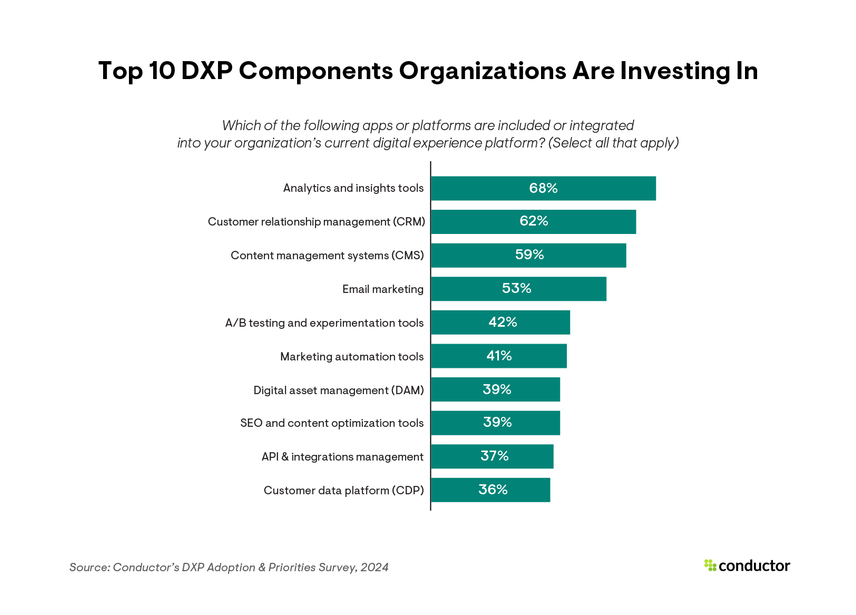
Below are detailed explanations of all DXP components included in the survey, including those not featured in the top 10 results, for a look at additional investment considerations.
- Content Management System (CMS): Serves as your content hub where teams create, edit, and publish content to ensure consistency and facilitate content distribution, primarily for the website.
- Digital Asset Management (DAM) Platform: Organizes, stores, and retrieves digital assets such as text, images, videos, and audio files, ensuring these assets are accessible and usable across different contexts and touchpoints to enhance content quality and management efficiency.
- Customer Data Platform (CDP): Unifies and segments customer data from various sources to provide a comprehensive view of the customer that enables truly personalized experiences.
- eCommerce Platform: Handles everything needed to run an online store. Facilitates online transactions and manages digital storefronts by handling payment processing, order management, and inventory tracking, enabling companies to conduct business online efficiently.
- Customer Relationship Management (CRM) Platform: Manages interactions with existing and potential customers by tracking customer data and interactions, building long-term relationships, and creating personalized experiences for each customer.
- Personalization Engine: Customizes digital experiences based on user data and behavior, using analytics and algorithms to deliver targeted content and interactions that enhance user engagement and satisfaction.
- Analytics & Insights Tools: Collects, analyzes, and reports on user behavior and content performance, turning that raw data into actionable insights to optimize user experiences and inform strategic decisions through data-driven analysis.
- Content Marketing Platforms: Streamlines the planning, creation, distribution, and analysis of content marketing efforts across different channels, aiming to drive brand awareness, engagement, and lead generation through strategic content initiatives.
- SEO, Content, & Website Optimization Tools: Enhances the visibility of websites and other content formats (think social posts, Reddit forums, YouTube videos, etc.) in search engines by optimizing for keywords, improving site structure, and ensuring high-quality content, thereby driving organic traffic, engagement, and conversions.
- Experimentation & Testing Tools: Conducts A/B testing and other forms of digital testing, allowing experimentation with content and design changes to optimize experiences and reduce risks using statistical analysis.
- Marketing Automation Tools: Automates marketing tasks—like email campaigns, social media posting, and lead nurturing—enhancing marketing efficiency and effectiveness through automated workflows that drive engagement and conversions.
- Social Media Management: Facilitates the creation, publication, management and analysis of social content, allowing for consistent brand messaging, engagement with audiences, and performance tracking across social channels.
- Email Marketing: Enables the creation, distribution, and tracking of email campaigns through features such as templates, segmentation, personalization, A/B testing, and analytics.
- Search and Navigation: Enables users to find relevant content quickly through advanced search algorithms, faceted navigation, and filtering within digital properties.
- API & Integration Framework: Provides flexible APIs and an open architecture to integrate third-party applications and services, allowing organizations to build a comprehensive and tailored digital experience platform.
As a first step to evaluating DXPs, identify your top priorities among these components to ensure whichever offering you consider provides your nonnegotiables.
However, implementing the right DXP as your central infrastructure is only half the battle, as infrastructure alone can’t create meaningful experiences. If the experiences delivered through your DXP are poor or are not optimized to succeed, it won’t matter how much you invest in your digital experience infrastructure.
You need to continuously optimize those digital experiences by having the right insights to drive ROI, and fuel growth. This is why it’s no surprise that analytics and insights tools rank as the most common component within DXPs, along with experimentation and SEO and content optimization tools—all key components of website optimization—in the top 10.
The emerging role of website optimization and intelligence within the DXP
DXP players are increasingly recognizing the importance of amplifying their foundational components with a website optimization and intelligence layer, whether natively or through third-party integrations.
Content is the lifeblood of any effective digital strategy. It engages audiences, tells your brand's story, and drives desired actions—from clicks and shares to conversions and loyalty. Yet, content must be both well-crafted and meticulously optimized for discoverability to reach and resonate with your target audience.
The CMS, DAM, CMP, and other foundational elements of a DXP are excellent at managing content logistics—storing, organizing, and distributing—but if that content isn’t optimized to be found, doesn’t resonate with audience needs, or drive to conversion, then the ROI and overall business growth will be minimal.
Marketing teams have historically looked at content creation and content delivery as two separate endeavors, neither very streamlined or optimized.
Disjointed systems and processes make scaling difficult, contribute to overspending on content creation, create an over-reliance on paid search, and inhibit performance measurement that proves the ROI of digital marketing spend.
While brands have access to a wealth of data from various channels, the website is the most accurate representation of customer perception and engagement. It is the cornerstone of your digital presence, where customers navigate to learn information, make purchases, and engage with content.
Unlike other channels, your website captures a wealth of real-time data, from page views and click-through rates to time spent on pages and conversion metrics. This data provides a comprehensive view of user behavior, giving you unmatched insights into your customers' needs and preferences.
Social media platforms often skew interactions through algorithms, while third-party eCommerce sites control customer data. In contrast, your website offers direct access to unfiltered insights straight from the source. These metrics empower you to customize user experiences, optimize marketing strategies, and respond swiftly to consumer preferences.
As a result, the website provides a deeper and more accurate understanding of customer needs and desires and stands as the most valuable asset in a brand's data-driven decision-making arsenal.
By leveraging the data and intelligence captured by your website, you can gain a deeper and more accurate understanding of your customers. This understanding is crucial to inform data-driven decisions regarding which optimizations to make—content, UX, or technical—to drive growth and long-term success.
What is website optimization and intelligence?
Website optimization & intelligence, sometimes referred to as digital experience optimization (DXO) , refers to the continuous process of analyzing your website to identify opportunity areas and implement changes to improve performance and deliver relevant content that addresses customer needs at every stage of their journey. In short, it’s an ongoing analysis of your website to optimize for three primary objectives, which include:
- Optimizing for search visibility and traffic. Because it doesn’t matter how great your content might be if it’s not ranking organically in search engines where your audience can find it; that’s where SEO comes in.
Considering that Google now processes nearly 8.5 billion searches per day, and organic search produces an average of 33% of a website’s overall traffic, it’s clear that organizations can no longer overlook the role optimized content plays in increasing search engine visibility and qualified traffic. SEO is a crucial aspect of website optimization as it empowers digital teams to create content that gets found and performs and provides search intent data to help inform other efforts to align with what customers are actively searching for. - Optimizing for UX. It also doesn’t matter how much traffic comes into your site if visitors can’t engage with your content. Technical site health and performance, such as page speed, are crucial aspects of UX. (Friendly reminder: 88% of users abandon a website after experiencing just one issue.) A lack of technical monitoring and optimization can result in negative customer experiences and severe revenue losses due to simple issues like broken links, outdated information, or poor sitemaps.
Another aspect is prioritizing digital accessibility. It’s estimated that in the U.S. alone, companies that ignore accessibility exclude nearly 20% of their total addressable market. - Optimizing for conversion. You can get the right content in front of the right audience and optimize those experiences, but it still might not deliver your desired business outcomes. Many website optimization solutions include or integrate with site analytics to track and measure key conversion metrics like purchases and signups to better understand what drives user behavior. Other solutions focus on testing and experimentation that provide data-driven insights to identify high-performing elements for more investment and fine-tune customer understanding for better targeting and personalization.
When it comes to the website, the top three priorities for organizations over the next 6-12 months are enhancing UX, boosting conversion rates, and increasing website traffic. These align directly with the core pillars of website optimization.
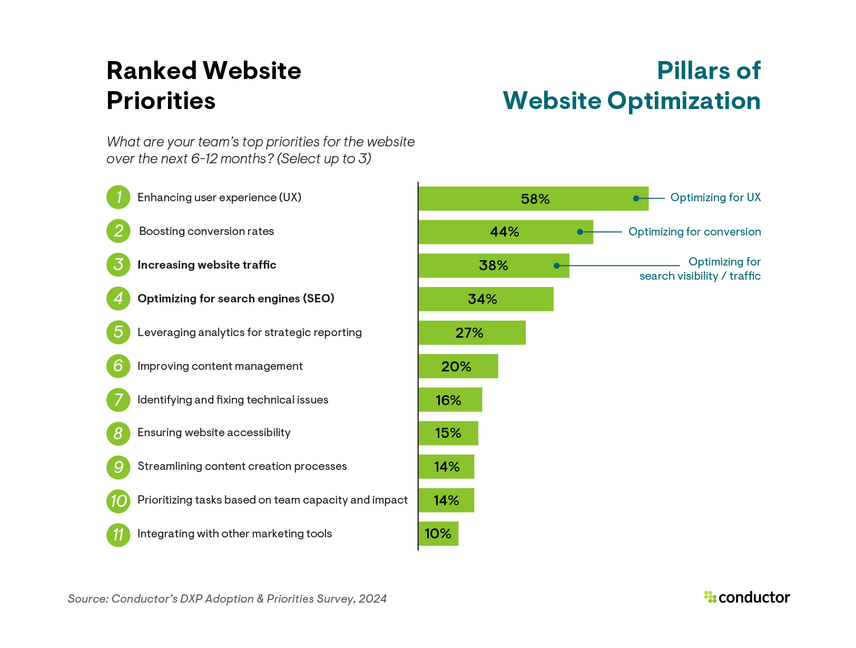
When segmenting survey data by function, the IT audience differs slightly from the average, prioritizing website accessibility instead of boosting conversions within the top 3. They also over-index, as compared to Product and Marketing, on technical issues and task prioritization.
Respondents ranked optimizing for search engines (SEO) as the next highest website priority for the next 6-12 months.
This isn’t a surprise, as SEO directly impacts all three of the preceding priorities. The top result on a Google search engine results page (SERP) has an average CTR of nearly 28% , page speed is a significant UX factor in Google’s algorithms for determining ranks, and the ability to align search intent with your content means a higher likelihood of converting.
It’s clear digital leaders recognize the opportunities resulting from SEO and are prioritizing it accordingly.
Website optimization and intelligence at the core of DXP
When it comes down to it, your website serves as the central hub of your digital presence, connecting and influencing all other digital touchpoints. It's often the first interaction between you and your potential customers, playing a critical role in shaping brand perception, driving customer engagement, and generating revenue. A well-optimized website guides customers through their entire journey, making it the primary digital growth driver for most organizations.
Because your website is so pivotal and has a profound impact on all other areas of your digital presence, the same principles and strategies used for website optimization and intelligence also apply to your broader DXP efforts.
For instance, by understanding which organic search terms are most effective in driving traffic to your website or which types of content users engage with most, you can make more strategic and cost-effective buys for paid search, leverage those same search terms and content in social and email messaging, inform future campaign efforts, and more. Embedding website optimization and intelligence capabilities within your DXP ensures that your digital initiatives are powered by the right insights.
This integrated approach allows you to leverage the valuable insights, data, and best practices from your website optimization efforts across all digital channels, resulting in a more cohesive, effective, and scalable digital strategy that delivers consistent, personalized, and engaging experiences across the entire customer journey.
Learn more about website optimization and access actionable strategies you can implement today with our in-depth guide.
For example, the CMS is often seen as the backbone of a DXP. But the CMS is really only a repository. It can store, organize, and distribute content efficiently but lacks the intrinsic ability to understand the context and nuance required to craft compelling content.
By integrating insights on competitors, performance, and best practices within the CMS, content teams have direct access to actionable data to move faster, create and optimize higher-quality content, and collaborate more effectively with the web teams that manage content publication and organization.
This could mean embedding SEO, content optimization, and analytics tools directly within the CMS interface, allowing content creators immediate access to optimization guidelines and performance metrics as they work to make sure everyone is on the same page, following best practices, and making decisions based on data. This transforms the content lifecycle from a linear process into a dynamic, iterative cycle where data and creative strategy continually inform and elevate each other.
In the same way that investing in a quality CMS isn’t enough to ensure a high-performing website if the content within it isn’t relevant or optimized, a broader DXP solution also needs to incorporate ongoing website optimization processes and intelligence to ensure the experiences delivered are meaningful and remain aligned with evolving customer needs.
The question becomes not ‘how much data can I derive’ because we can get a lot of data. The question is, ‘what is the exact data that I need?’
The best tools collect relevant data for the task at hand and integrate it with content syndicators on the same platform, keeping creation and data together rather than having to go back and forth.
Even though it seems minor, it simplifies work significantly.
By embedding these website optimization and intelligence capabilities within the robust infrastructure of DXP, businesses ensure that content is created efficiently and optimized for effectiveness from the outset; enabling them to leverage the full potential of their digital presence.
The synergy between good infrastructure and great content ensures that digital experiences are both technically sound and rich in value, ultimately driving traffic, engagement, and conversion.
However, the tech used to optimize these website metrics is not always directly perceived as part of the DXP. To get even more specific, we asked DXP users which specific website optimization capabilities were most important to have integrated into their current DXP rather than managing it as a separate tool.
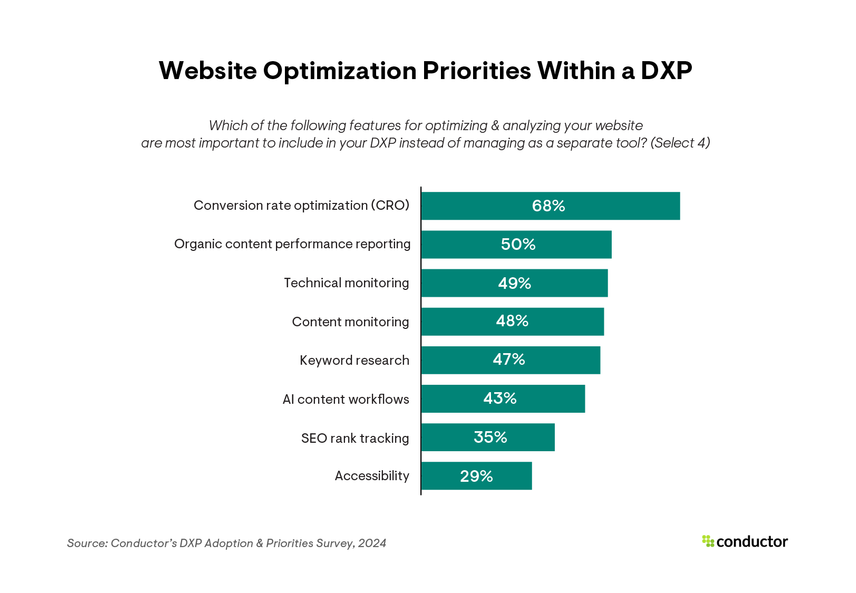
Conversion rate optimization and content performance are the top two website optimization capabilities that respondents want to be integrated within their DXP, which aligns with overall website priorities. Technical and content monitoring follow in priority, indicating clear value in quickly detecting and fixing issues.
While the adoption of one-off tools for AI content workflows is rising, it ranked #6 overall, likely because it is not yet perceived as table stakes to be integrated within a DXP.
It's interesting to note that it was selected more frequently by IT (49%), who may have a greater desire for toolset consolidation, and decision-maker (50%) audiences, given the growing strategic considerations around AI.
The top four DXP optimization priorities also align directly with the key pillars of website optimization:
- Conversion rate optimization -> Optimizing for conversion to boost revenue and business outcomes
- Content performance reporting -> Optimizing for increased organic search traffic and content discoverability through SEO and ensuring content is relevant + aligns with search demand
- Technical & content monitoring -> Optimizing for UX by proactively detecting and resolving issues that may impact the user experience
And it’s not just SEO or digital marketers who rely on these website optimization and intelligence insights to inform their strategy.
Analytics teams need comprehensive website data that tells them more than just the number of visits, bounces, and time spent on each page to provide informed recommendations. IT and website development teams need technical website monitoring to protect and ensure successful UX throughout the site. Digital product teams rely on product page performance insights and audience search-related behavior to identify product development needs and new feature opportunities.
Let’s look at an example of website optimization and insights integrated directly into a DXP.
Acquia SEO Case Study: Integrating SEO insights directly into the CMS
Acquia SEO (powered by Conductor) is an integration within Drupal CMS that provides on-demand SEO insights—from keywordKeyword
A keyword is what users write into a search engine when they want to find something specific.
Learn more opportunities to heading and body copy suggestions—and AI-powered content recommendations as you write.
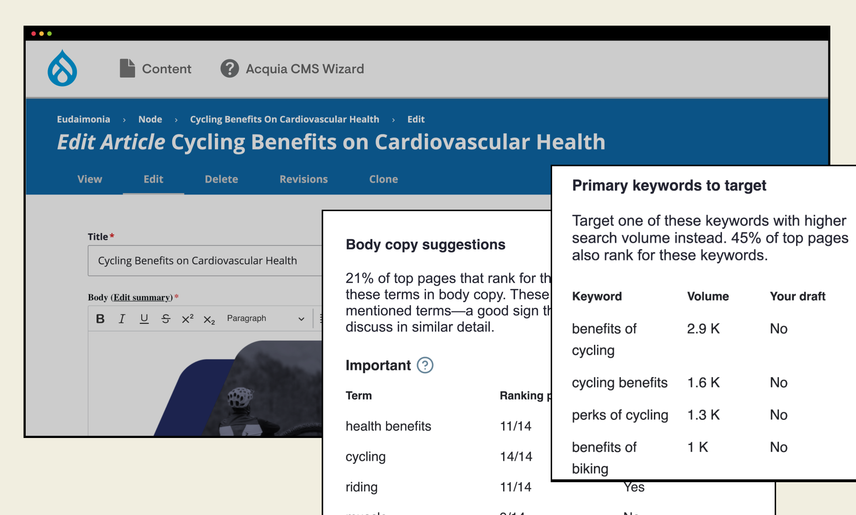
Acquia SEO helps evaluate your in-progress content against key ranking factors by automatically aggregating intel around top-performing competitors to learn what they’re doing to rank and how your content compares—directly in the CMS.
For any topic, see semantically similar keywords with higher search demand that you might want to try and rank for instead. Get suggestions for important terms to include in your body copy and headers. Also see the top People Also Ask questions on Google and, with the help of AI, get an analysis of how well your content answers the queries your visitors are searching for, along with suggestions on how to improve.
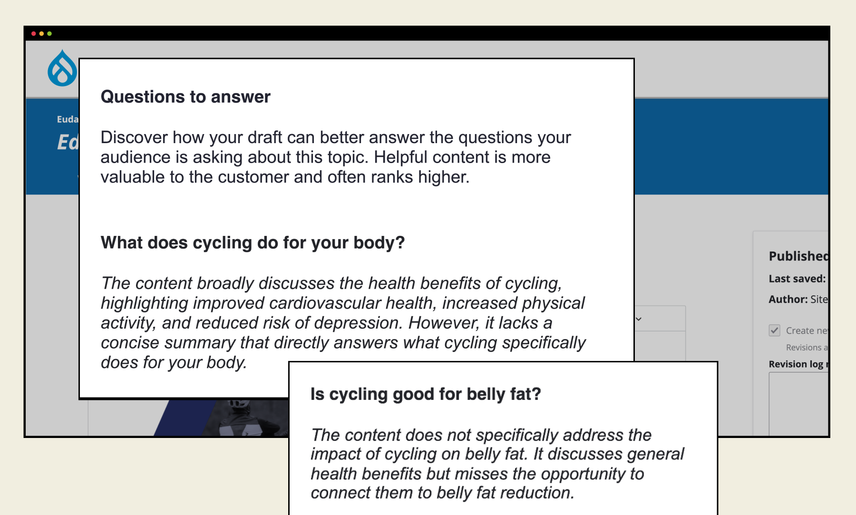
The dynamic content score simplifies SEO for every contributor by summarizing how well your content addresses your target topic overall and how likely it is to rank well on SERPs.
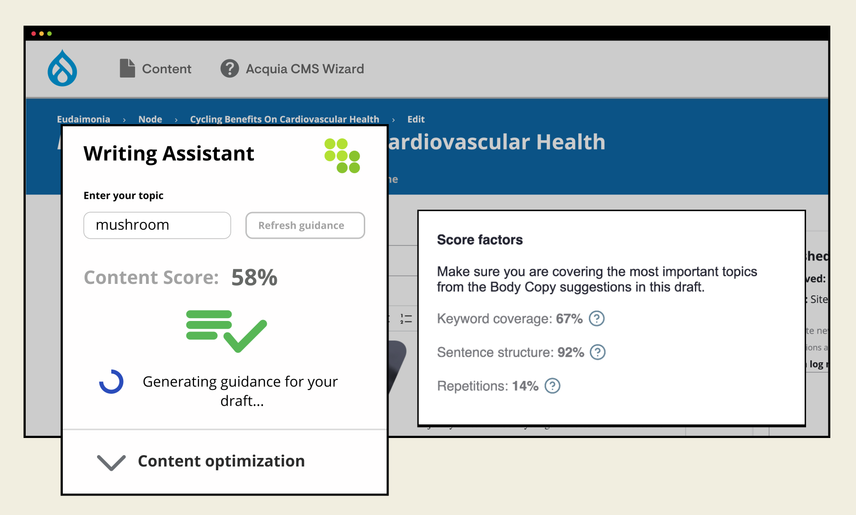
This integration ensures that content is generated efficiently and fine-tuned for discoverability and engagement from the moment you start writing.
Content teams can make more informed decisions and quickly align multiple contributors around the same set of data-driven best practices to ensure content is primed to succeed in driving value and gaining traffic right away. It transforms the CMS from a repository into an intelligent hub where content is continuously refined and aligned with strategic goals.
A comprehensive content strategy supported by an intelligence layer such as Acquia DXO can improve the performance of your digital experiences, particularly when it’s aligned with other key technologies to execute campaigns that move your customers along the path from awareness to purchase.
Here are a few more ways website optimization and intelligence can be integrated within DXP components for effective digital experience optimization:
- CMP: Using search insights to prioritize high-impact topics for campaigns.
- Analytics: Monitoring how users interact with website content to optimize user journeys and identify opportunity areas.
- Personalization engine: Tailoring content and recommendations based on the user’s search intent and behavior patterns to increase relevance.
- eCommerce: Using keyword insights to optimize product descriptions and categories, along with monitoring your digital storefront for any issues that may impact purchase.
- DAM: Ensuring that all digital assets, such as images and videos, have metadata optimized for SEO, including alt tags, descriptions, and titles with relevant keywords.
- CRM: Using keyword and competitor research to optimize visibility and engagement when mapping the customer journey within the CRM and monitoring the technical health of conversion-driving or campaign landing pages.
- Testing/experimentation: Monitoring any technical or compliance issues, such as slow loading times, that can occur when deploying these types of technologies and that can negatively affect user experience.
How to choose a DXP
Investment in a digital experience platform is a significant business decision. While it can feel daunting, one guiding principle is that it should be a fundamentally flexible platform built for expansion instead of needing to forcibly tack on digital features to pre-existing systems.
As budgets remain tight for most digital teams in 2025, you can always consider starting with an investment in one component from any DXP vendor. As your organization’s level of digital maturity increases, you can integrate additional components without needing a significant tech overhaul.
Depending on your business needs and budget, there are several attributes to consider when evaluating a DXP investment, including:
- Personalized GenAI Content Capabilities: To create and optimize content with AI that aligns with your brand and customer data
- Headless CMS and Composable DXP Architecture: For flexibility to add best-in-class tech components to align with your digital strategy, even as it grows
- Pre-built Integrations and Low-Code Interfaces: That work as is or take minimal coding for quick assembly of needed capabilities
- Advanced Personalization: Powered by real-time data and AI to automate personalized customer experiences and insights
- AI Workflow Management: That integrates seamlessly across multiple tools, pulling documentation and analytics to enhance decision making
- Website Optimization & Intelligence Capabilities: To use first-party data to create and optimize content and user experiences to increase search engine visibility, content discoverability, and organic search traffic

Conclusion
In today’s digital landscape, DXPs have become essential for delivering unified, personalized experiences across every digital touchpoint. These platforms provide the infrastructure needed to manage complex digital ecosystems and improve the customer experience while breaking down the data silos and operational inefficiencies that hinder growth.
However, infrastructure alone isn’t enough to drive success. By integrating website optimization and intelligence capabilities within your DXP investment, you can ensure your content isn’t just managed efficiently—it’s discoverable, engaging, and driving tangible business outcomes. This optimization layer empowers digital teams to create data-driven experiences that consistently attract, engage, and convert while maximizing ROI.
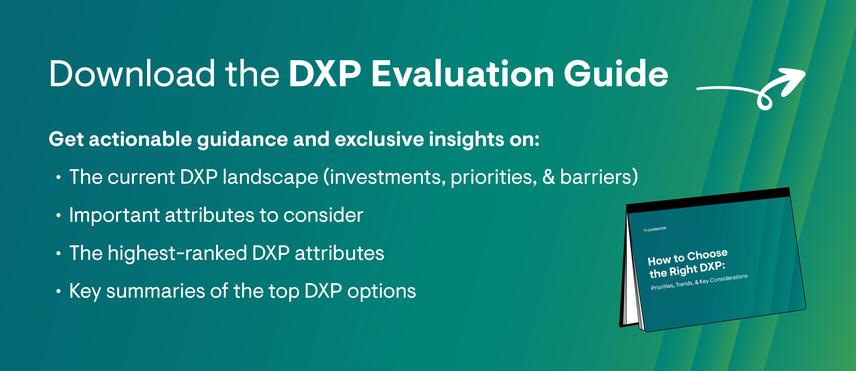
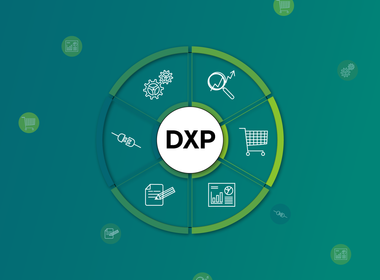
![Alan Botwright, Director of Product & Solutions Marketing, [object Object]](https://cdn.sanity.io/images/tkl0o0xu/production/cbf7e860828cbd2f6676ccad36ac693a400d4b0c-500x500.jpg?fit=min&w=100&h=100&dpr=1&q=95)
![Jeffrey Cheal, VP of Global Strategic & Technology Partnerships, [object Object]](https://cdn.sanity.io/images/tkl0o0xu/production/861977f8ad139607506e5a26ddb1b876c9017b70-500x500.jpg?fit=min&w=100&h=100&dpr=1&q=95)







